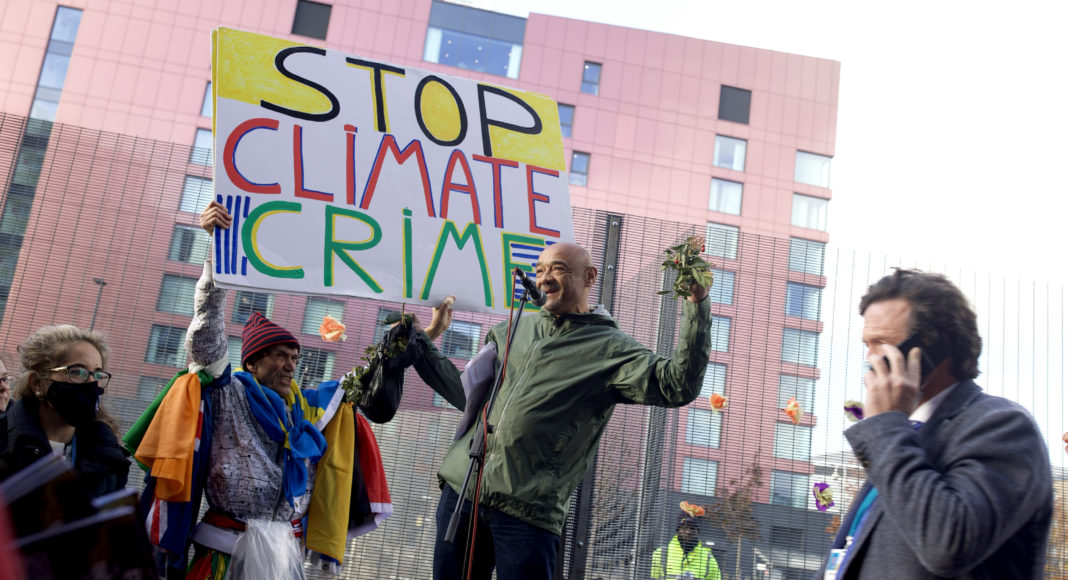GLASGOW (Scotland) On Thursday 3 November, as I left London for Glasgow, I could see billboards and posters on the stations and in the streets peddling the much-hyped COP26 as the ‘last best chance to save the planet’. Yet when a slogan like that stares you in the face, you are left asking who we are saving the planet from, and for whom?
Far from the spotlights of the conference’s vaunted Green and Blue Zones, the reality presented on the streets around the conference centre is completely different and echoes the cries for more effective climate solutions.
Business in the Blue Zone
The Blue Zone is reserved for those officially registered with the UN event who are charged, supposedly, with coordinating the global response to the threat of climate change. The Green Zone is where workshops, presentations, and art exhibitions take place, and is aimed at the general public.
Last Friday 5 November, the protest organized by Friday for Future and led by indigenous peoples from different countries, brought together around 25,000 students and environmental activists. It prepared the ground for the following day’s march, which raised the flag for ‘climate justice’ and brought more than 100,000 people together to brave the strong, cold wind and the damp – the dreich, as the Scottish say – a day without light, heat, or colour.

Yet the echoes of the music, chants and slogans not only invaded the silence of the restricted areas, to which few have access, but attracted a rich and varied throng of people to the streets, who overwhelmed and gave new meaning to the Scottish dreich.
The two marches were able to break down the evident cognitive disconnection of COP26, which embodies the fundamental illusion that the environmental problems of the planet will be solved ‘by economic power’ in the form of financial investments and technological and scientific resources, but without seriously considering or analysing the role of nature and of the peoples that inhabit the most threatened biomes.
Inside the restricted rooms and controlled environments, salvation of the planet is being touted in the shape of the latest, newest products to be sold by the very same companies that are destroying the planet. ‘Aggregating value’, ‘ ‘business innovation’, and the newest ‘green technology’ seem to be the mantras of those who in truth know perfectly well that the world-view underlying all these so-called new ideas, is precisely what is leading us towards climate catastrophe.
No room at the table
How dare we propose a ‘salvation of the planet’, when we exclude from the negotiating table representatives from the countries most effected by the climate crisis, be it those from Brazil, elsewhere in Latin-America, the Caribbean, or Africa, as well as those members of societies everywhere that are historically silenced or ignored?
This deliberate exclusion avoids monitoring and pressure by the absent delegations, leaving the power of decision in the hands of governments, behind closed doors. And the exclusion is implemented in the form of health restrictions, financial restrictions, or simply lack of access to the ‘official zones’ where discussion takes place.
Is COP26 just a stopgap to enable decision-makers to cool the passions of a more concerned global community that demands action? And this at a point when the same political and economic elites cannot even cool down the consequences of the irreversible climate crisis?
At an event organized in The New York Times Climate Hub, British actress Emma Watson, the activists Malala Yousafzai, Greta Thunberg, Amanda Gorman, Vanessa Nakate, Tori Tsui, Dominique Palmer, Ati Gunnawi, Viviam Misslin Izquierdo, Mya-Rose Craig, and Daphne Frias got together to discuss the power of climate activism.
Greta Thunberg stated her skepticism about the platform and declared that it is necessary to create awareness so that the people around the world know what really goes on at these conferences.
‘Without massive pressure from the outside, they will continue to get away with not doing anything and just continue doing ”blah-blah-blah” and not being held accountable […] We are so far from what would actually be needed, I think what would be considered success would be if people realized what a failure this COP is’.
The voices that are raised outside the restricted environments and take over the streets of Glasgow are the voices of those who, for thousands of years, have known how to live with and understand the Earth as a living system. They go far beyond the present transformation of everything into merchandise, and see as far ahead as our extinction. These voices point to other directions, other connections, other ideas, other possible worlds that are completely different to those offered by COP26.
Marcos Colón coordinates the Portuguese Program of the Department of Modern Languages and Linguistics at Florida State University and is the director of the documentary ‘Beyond Fordlândia. He has a doctorate in cultural studies from the University of Wisconsin-Madison. He is founder and editor-in-chief of Amazônia Latitude.
A similar article by the same author appeared in Folha de S.Paulo on 9 November (in Portuguese).
Main image: Outside the zone exclusion. 9 November 2021. Image: Marcos Colón, Amazônia Latitude

